A valid architecture evokes many levels of meaning and combinations of focus: its space and its elements become readable and workable in several ways at once. But an architecture of complexity and contradiction has a special obligation toward the whole: its truth must be in its totality or its implications of totality. It must embody the difficult unity of inclusion rather than the easy unity of exclusion. More is not less.1 Robert Venturi, Complexity & Contradiction in Architecture(New York: Museum of Modern Art, 1966), 16.
Kyle Miller
Nine Lies
In Complexity and Contradiction in Architecture Robert Venturi argues for the construction of truth in a building through its “implications of totality.” However, in its pursuit of physical unity, this totality may not necessarily ensure only truth. The message of “totality” may be multifarious—completed with a clever concoction of partial truths and even lies. In the invocation and evocation of meaning, there exists the opportunity for deception and the slight of hand in the transmission and reception of architectural messages. Knowns may become unknowns, the familiar may become unfamiliar, and the fixed may become unhinged.
In the project of complexity and contradiction, the sum of the parts—in this instance, the fundamental elements of architecture—is always greater than the whole. As a result, the truth embedded in the individual parts does not necessarily aggregate to construct a truthful whole. What follows are nine lies.
The Noble Lie2 A noble lie is one that would normally cause discord if uncovered, but offers some benefit to the liar and assists in an orderly society, therefore, potentially beneficial to others. It is often told to maintain order and safety. (Source: Wikipedia)
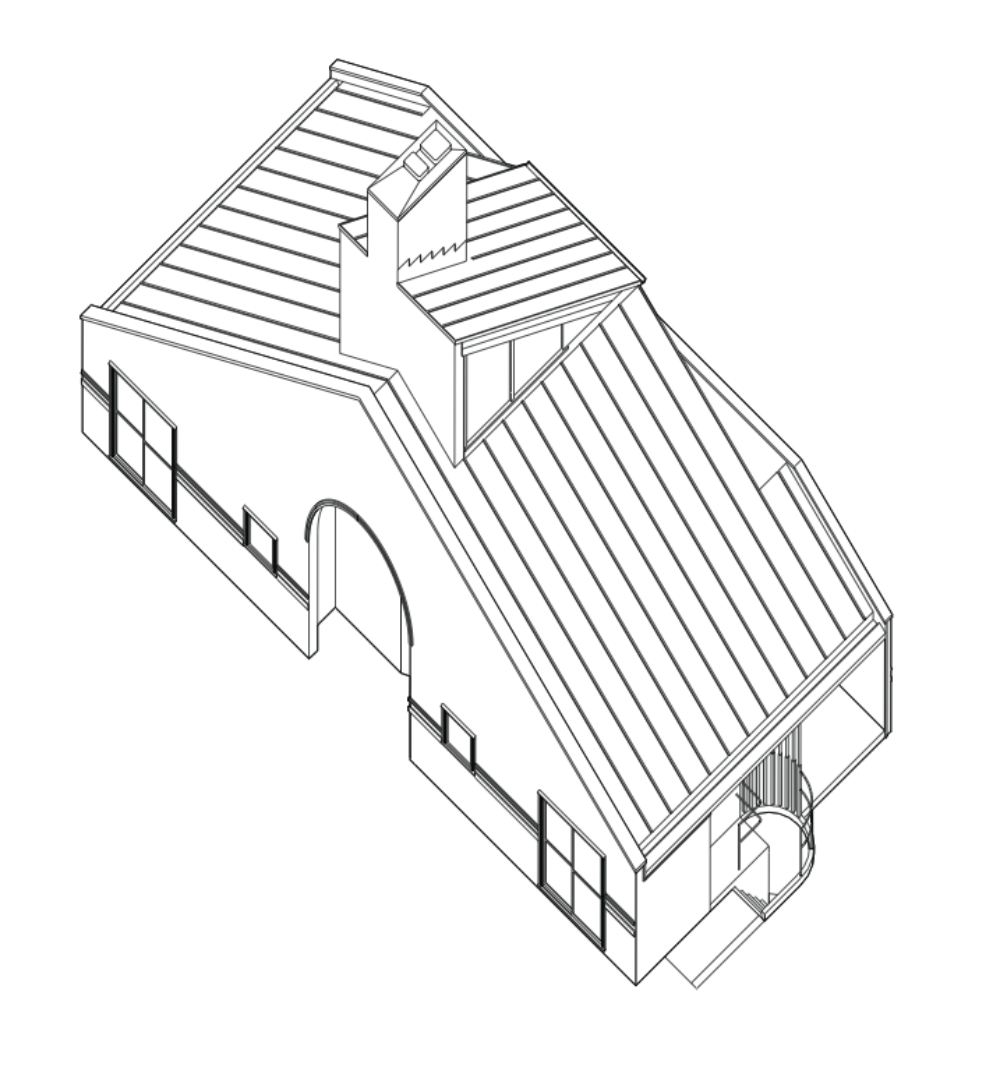
The Vanna Venturi House, originally titled My Mother’s House,3 Heinrich Klotz, Postmodern Visions, (New York: Abbeville Press, 1985) 325. was designed by Robert Venturi and constructed between 1962 and 1964. This house embodies many of the principles that Venturi solidifies during the development of his 1966 publication Complexity and Contradiction in Architecture. Venturi claims that architects must be reverent to the language of classical architecture. This house expresses the purity of architectural elements, which are "clear," and "straightforward." The Vanna Venturi House stands for unity.4 Robert Venturi, Complexity & Contradiction in Architecture(New York: Museum of Modern Art, 1966), 16.
Through relentless symmetry in both the overall geometric composition and the placement of its specific elements, the front facade of the Vanna Venturi House expresses centrality and singularity. The dominant triangular shape, central hearth, continuous structural arch, and mirroring of windows reinforce Venturi’s commitment to clarity and the unified whole. A double-strip of molding runs around the house, uniting the individual elements on the front facade with those on the rear facade, which displays a continued commitment to symmetry through the regular arrangement of doors and windows crowned by a fanlight on the central axis, a motif first introduced in Venturi’s Guild House, constructed in 1963.
The Fib5 An untrue statement about something minor or unimportant. (Source: Merriam-Webster Dictionary). A fib is a lie told with no malicious intent and little consequence.
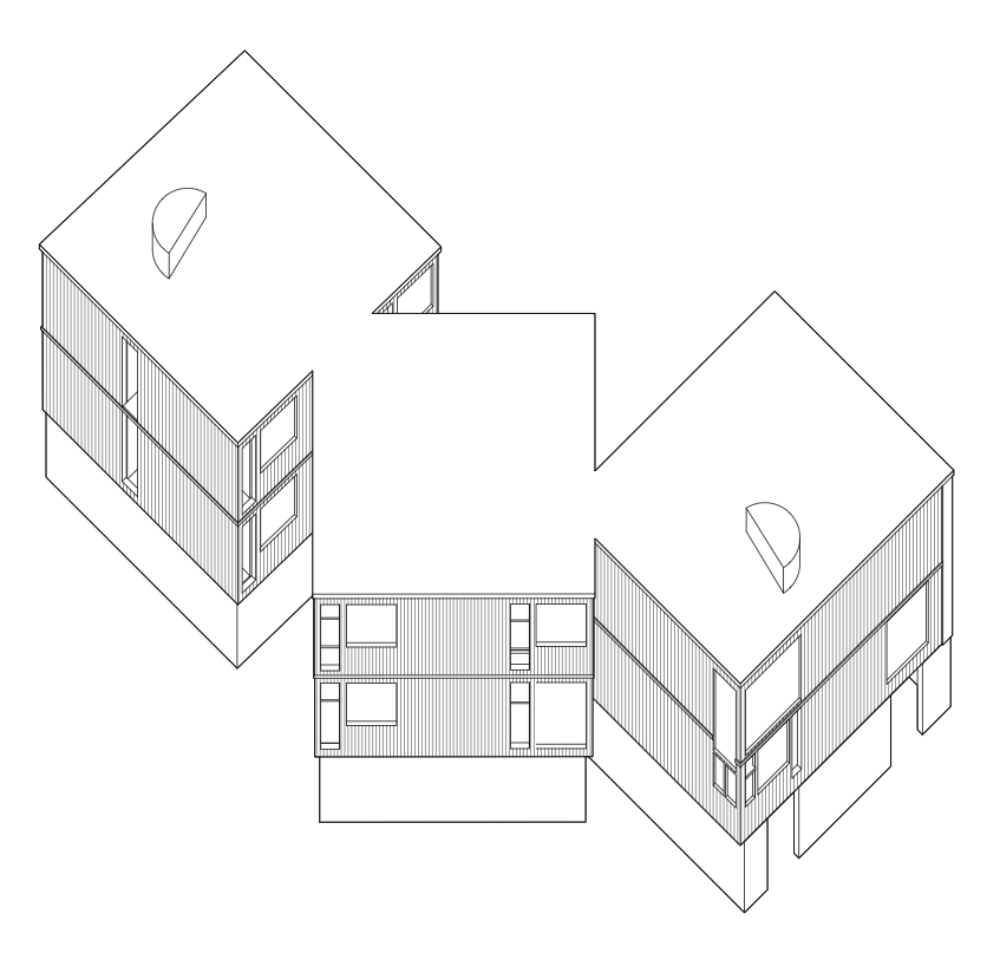
Louis Kahn’s Fisher House, constructed in 1967 in Harboro, Pennsylvania, renounces the strict linearity found in most modern plan organizations and focuses on simple shapes that engage one another, not along edges or at corners, but by piercing edges with corners. In the Fisher House, this arrangement produces a unified collective that places emphasis on the legibility and autonomy of its parts over a singular whole.
This clever strategy for physical engagement between the parts—three cubic volumes—allows for both internal continuity and clear separation of public and private spaces. The centralized volume, oriented on the north-south axis, contains the private living quarters and has distinct thresholds along its perimeter that connect this centralized space to the living, dining, kitchen, and working areas in the adjacent volumes, which are placed 45 degrees off axis and run parallel to the driveway. The decision to create three distinct volumes was driven by the original design requirement of a home, a physician’s office, and an artist’s studio.6 Joseph Rykwert, Louis Kahn. (New York: Harry N. Abrams Inc., 2001), 110. Though the office was dropped from the project, the three volumes remain. The thresholds between them serve the need for privacy in a family home.
Half Truth7 A half-truth is a deceptive statement that includes some element of truth. The statement might be partly true, the statement may be totally true but only part of the whole truth, or it may employ some deceptive element, such as improper punctuation, or double meaning, especially if the intent is to deceive, evade, blame or misrepresent the truth. (Source: Merriam-Webster Dictionary)
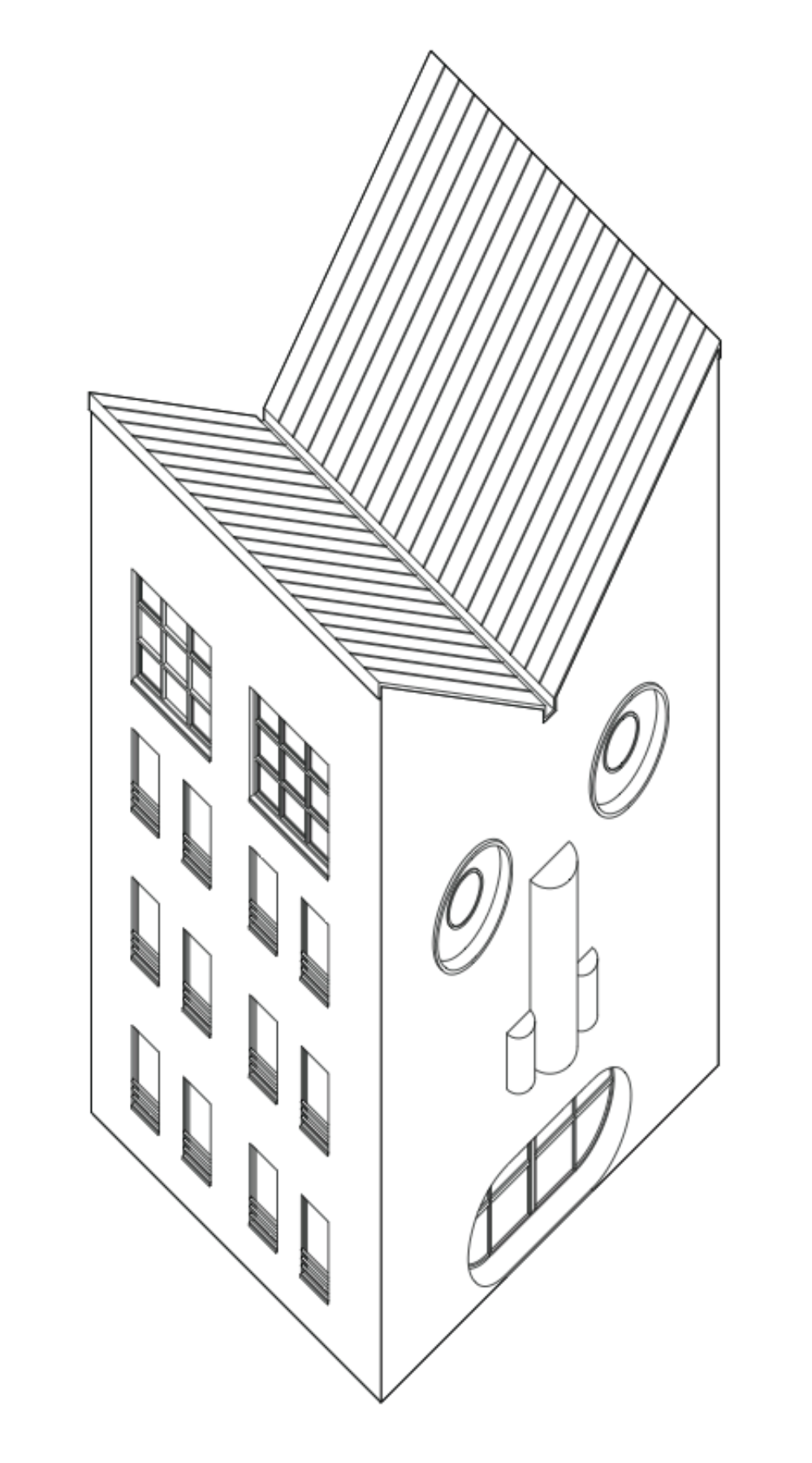
The Kreuzberg Face House was designed as part of the 1987 International BauAufstellung (IBA) Program. The IBA invited noted architects and designers to envision new low- and middle-income housing for West Berlin.8 “AD Classics: The Kreuzberg Tower / John Hejduk,” ArchDaily, accessed November 23, 2014, http://www.archdaily.com/164259/ad-classics-the-kreuzberg-tower-john-hejduk/ Constructed in 1988, the Kreuzberg Face House, with an emphasis placed on the legibility of facial features such as eyes, a nose, and a mouth, serves as an emblem of postmodern architecture—an architectural movement that prioritized wit and reference to defeat the cold, inaccessible forms and features of modern architecture.
The neutral colored structure features white geometric forms that are attached to the facades and quite directly resembles a face. The eyes, inverted extrusions on the third floor, serve as widows for the low income housing units that sit atop the design studio, accessible through the mouth at ground level. Visitors to the studio are swallowed by a scowl, the eyes bulge out, the nose needs plastic surgery, and the ears are perked up.9 Charles Jenks, The Language of Post-Modern Architecture, (New York: Rizzoli, 1977), 116. The graphic designer who occupied the ground floor encouraged the inclusion of these facial features to make this building stand apart from the banal neighboring houses, to draw attention to his business.
Perjury10 Perjury is the act of lying or making verifiably false statements on a material matter under oath or affirmation in a court of law, or in any of various sworn statements in writing. Perjury is a crime. (Source: Wikipedia)
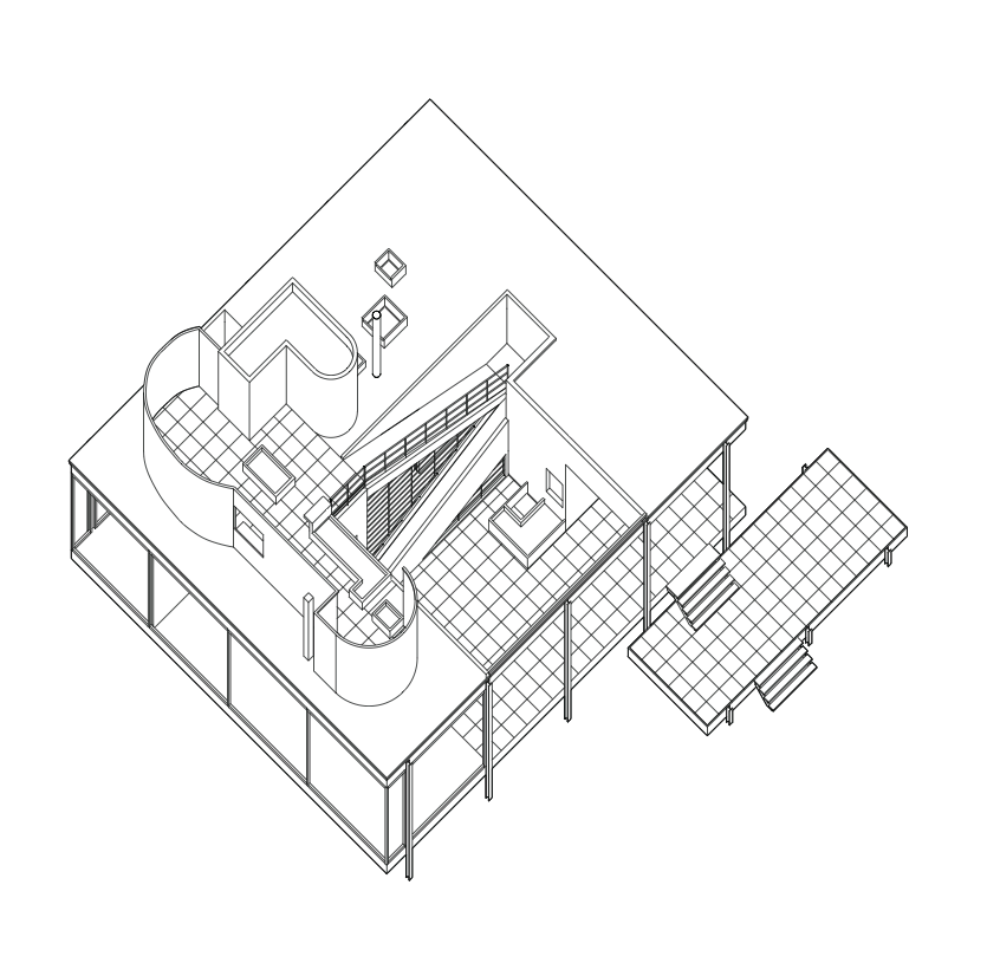
Villa Farnsavoye was constructed in 1936 and strictly adheres to the following six points of architecture established by Le Corbusier just 10 years earlier: 1) the supports, 2) the free slab, 3) the roof gardens, 4) the free designing of the plan, 5) the horizontal window, and 6) free design of the facade.11 Le Corbusier/Pierre Jeanneret, "Five Points Toward a New Architecture" in Programs and Manifestos in Twentieth Century Architecture. (Boston: MIT Press, 1975), 100. The six points present the architect with a “box of building units” upon which architectural talent can operate freely.12 Le Corbusier/Pierre Jeanneret, "Five Points Toward a New Architecture," 101.
In Villa Farnsavoye, the six points of architecture are prominently featured. The isolated supports clearly identify themselves as the elements of the house that are performing structurally. The supports enable the free slab and the roof garden. The free, floating slab lifts the house from the land and establishes a new ground while the roof garden is populated with a variety of plant species and becomes a desirable gathering space and another new ground. The supports also enable the free designing of the plan. In Villa Farnsavoye walls are placed wherever separation between activities is desired or required. The free design of the facade allows for and incorporates the expansive horizontal window, which allows rooms to be adequately lit from wall to wall. Villa Farnsavoye confidently proclaims that the “age of the architects is coming.”13 Le Corbusier/Pierre Jeanneret, "Five Points Toward a New Architecture," 101.
The White-Lie14 White lies are minor lies, which could be considered to be harmless, or even beneficial, in the long term. A common version of a white lie is to tell only part of the truth, therefore not be suspected of lying, yet also conceal something else, to avoid awkward questions. (Source: Wikipedia)
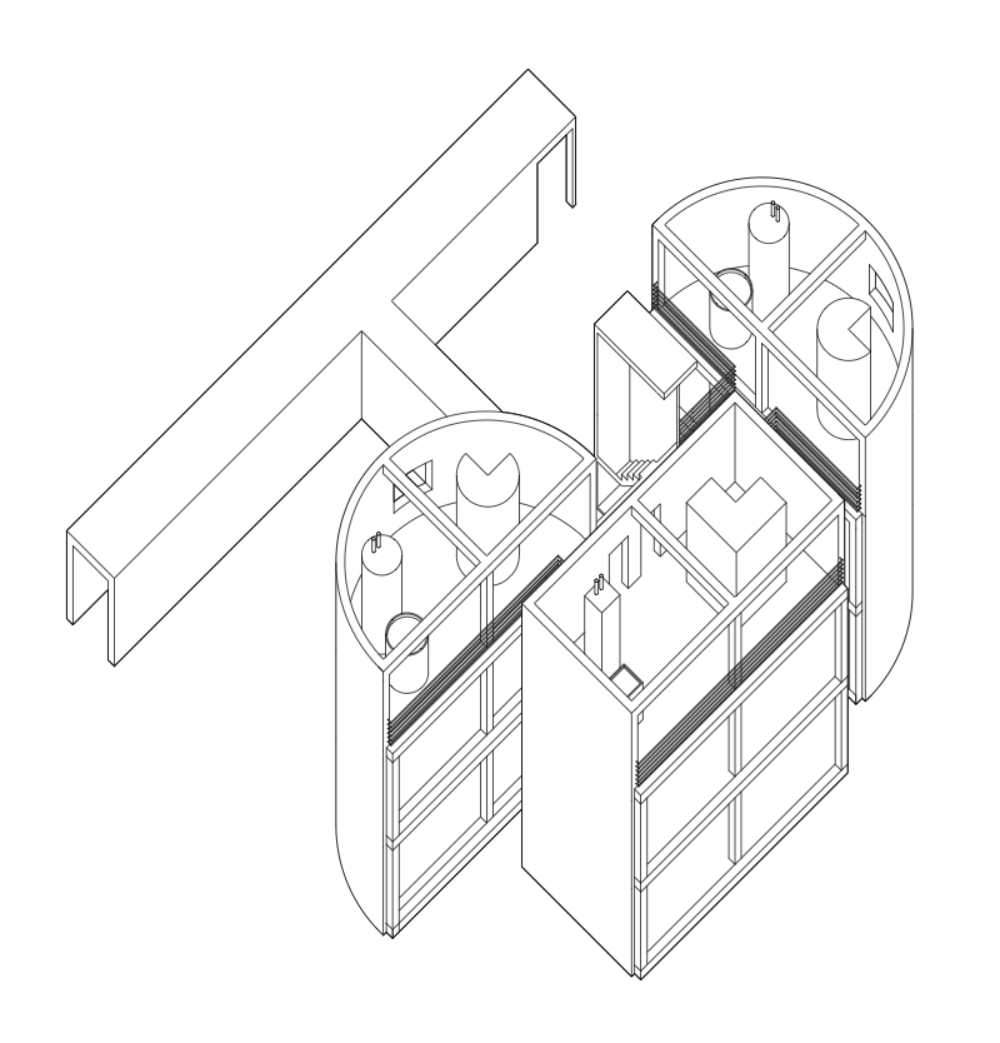
The One-Half House, designed by John Hejduk in 1966, is a playful assemblage of incomplete shapes—one half-square and two half-circle forms. These extruded half-shapes are huddled around a vertical core, accessed only by horizontal shaft that sits adjacent to the habitable extrusions. The lowest levels of the half-forms contain three separate bedrooms, while the upper levels house the social spaces. The kitchen can be found on the second level of the half-square extrusion. The dining area is located within the half-circle extrusion whose open face is bisected by the external corridor. An entertainment area, fit out with a piano and a bar, occupy the second level of the half-circle extrusion at the opposite end of the external corridor. The uppermost levels are a collection of outdoor living spaces.
The One-Half House can be understood as a transitional project for Hejduk. Positioned chronologically in-between the strict compositional strategies employed in the Diamond House series and the fluid, figural forms showcased in the Wall House, the One-Half House breaks the strict singular, rectilinear container found in work prior and opens up the possibility for expressive, curvilinear massing found in work after.
The Jocose Lie15 Jocose lies are lies meant in jest, intended to be understood as such by all present parties. (Source: Wikipedia)
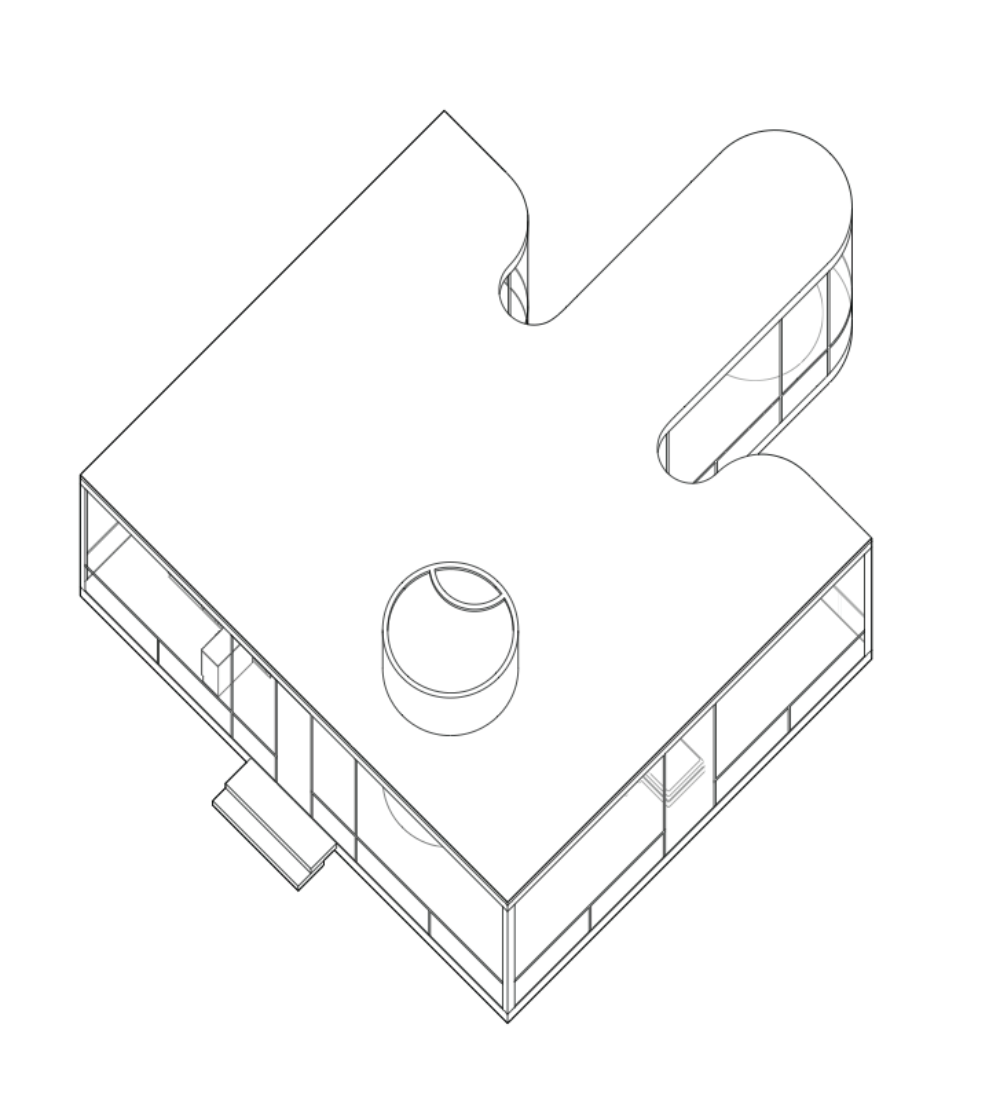
In 1994, the Glass Daisy House was constructed outside of Youngstown, Ohio, on the southern tip of McKelvey Lake. The project thrives on a constructed tension between the non-associative, strictly linear forms commonly found in modern architecture and the strong figural, associative forms found in postmodern architecture. The south-facing elevation of the Glass Daisy House is a simple rectangle subdivided into smaller rectangles. The main entry is positioned centrally within this facade and is flanked by a symmetrical composition of charcoal-painted steel mullions and tempered glass. In its rhythmic undulation, the north-facing elevation is much more expressive and alluring. The result of a vertical extrusion, the form is erected from a phallus-shaped extension from the regular rectangle that composes the remainder of the house.16 Charles Jencks, The New Paradigm in Architecture: The Language of Post-modernism, (New Haven: Yale University Press, 2002), 83.
In its internal conflation of opposing form-making sensibilities, Glass Daisy House is both contingent and autonomous, lavish and austere, expressive and mute, referential and anonymous.
Lying by Omission17 A lie by omission occurs when an important fact is left out in order to foster a misconception. Lying by omission includes failures to correct pre-existing misconceptions. (Source: Wikipedia)
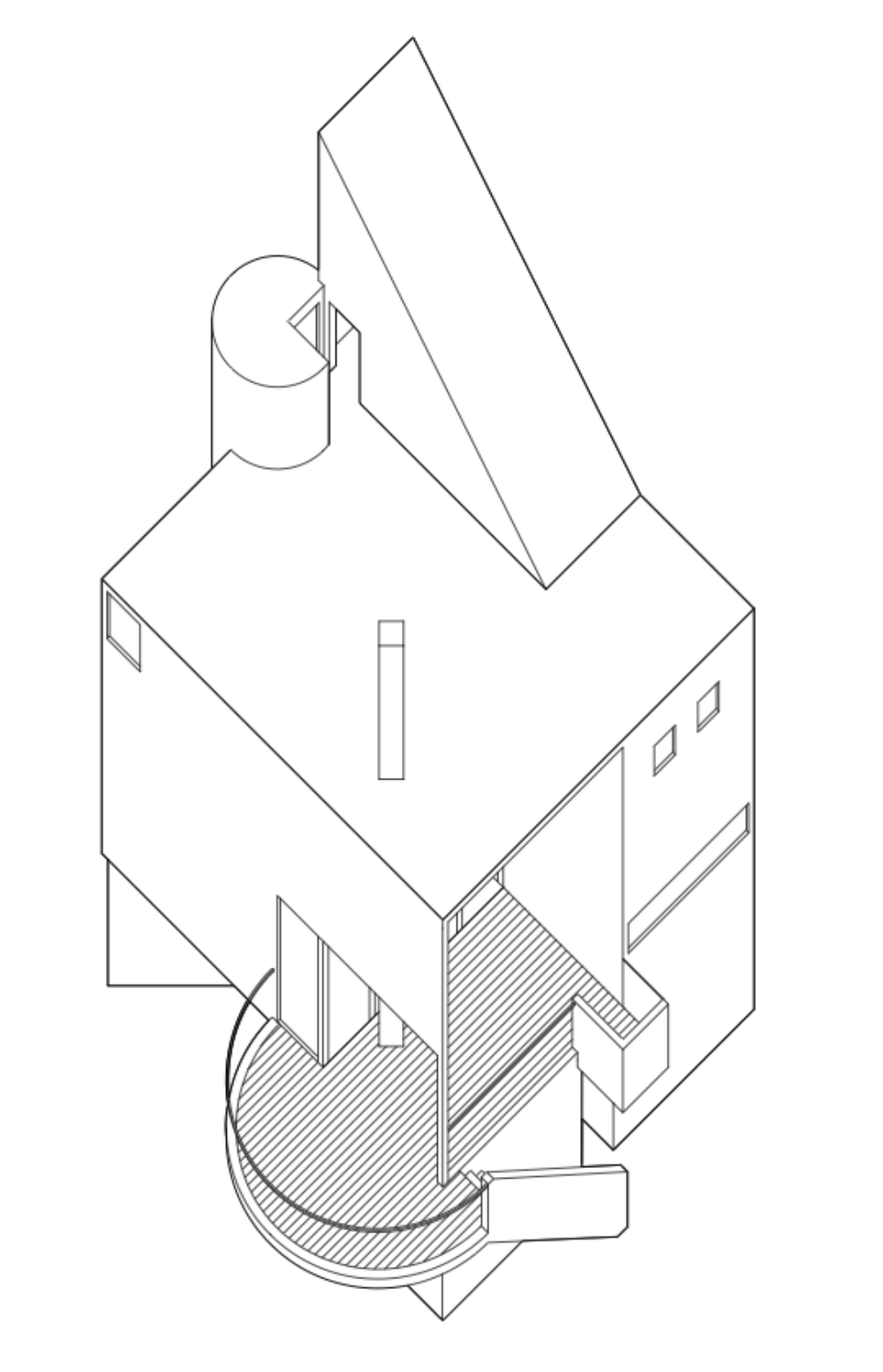
“As poised as a chess piece on a green playing field,” the Gwathmey Residence is a composition of geometric forms—primarily cylinders intersecting a central cube.18 Julie Iovine, “Polishing Up a Well-Cut Gem” in New York Times Archive, accessed December 21st, 2014, http://www.nytimes.com/2002/06/06/garden/design-notebook-polishing-up-a-well-cut-gem.html
The Gwathmey Residence emphasizes three-dimensional shapes through the volumetric interpenetration of solids to create functional voids. The “carving” of these spaces was determined by responses to the site, solar orientation, program, and structure. In the middle of the structure, a cube is subtracted from a larger cube to create a double height outdoor space elevated above the ground and accessible from a staircase that presents itself as the remnants of two triangular forms subtracted from a larger cube. At the ground floor, a triangular extrusion is removed, reoriented, and shifted to the roof becoming the most prominent vertical volume. Compositionally, half circles dance around the central cube receiving both stairs and slabs and resolving themselves, through extrusions, as both plane and mass. In the Gwathmey Residence, such a play of plane and mass is indicative of a larger body of work produced by Charles Gwathmey that presents a thorough study of inventive modernist geometries.
View From Nowhere19 The view from nowhere refers to journalism and analysis that misinform the audience by creating the impression that opposing parties to an issue have equal correctness and validity, even when the truths of their claims are mutually exclusive. (Source: Wikipedia)
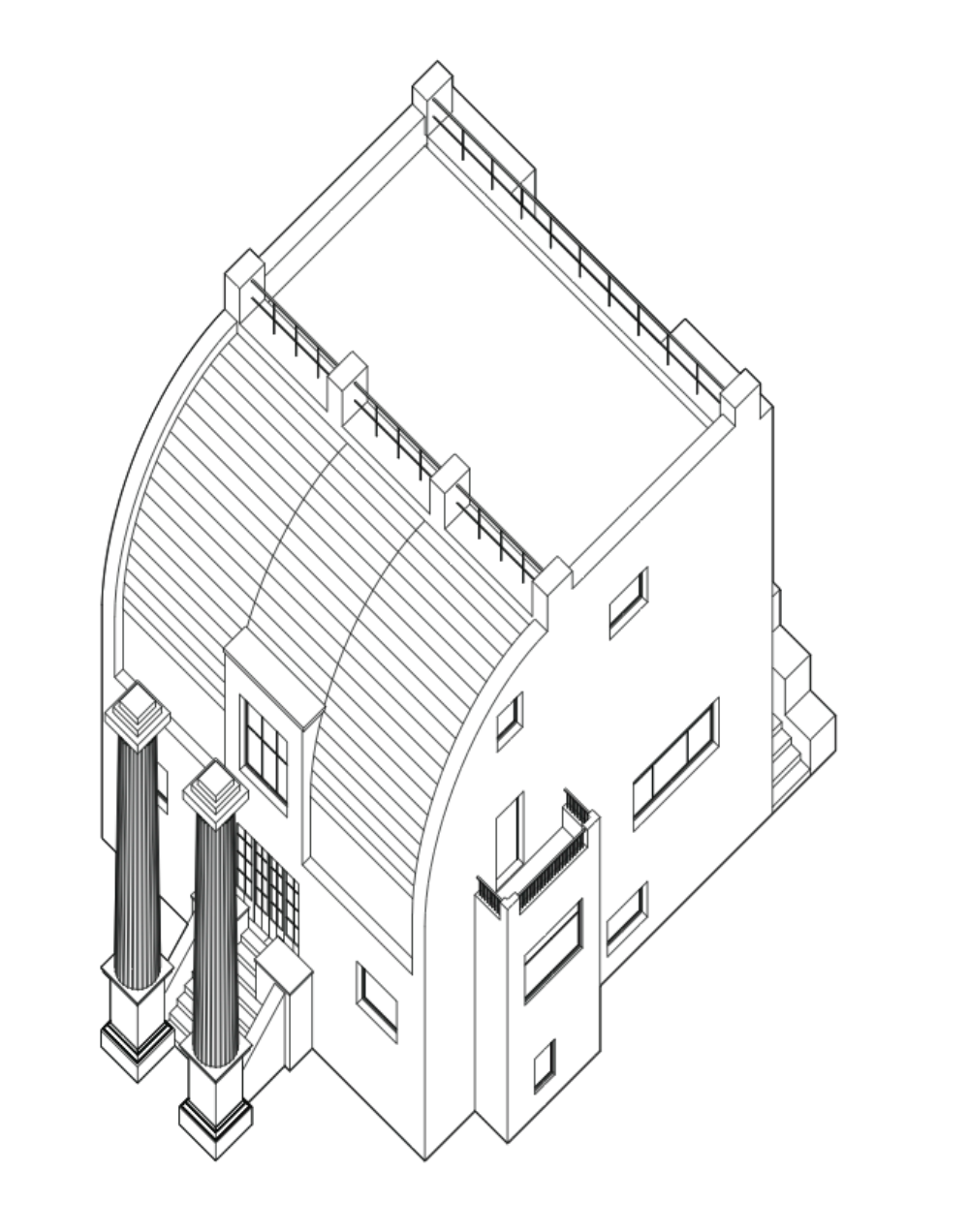
Haus Steiner was designed by Adolf Loos and constructed in Vienna in 1910. This private residence is comprised of simple volumes, most notably a quarter-round roof which faces the street and conceals the private garden at the back of the lot. Haus Steiner has a stucco facade like most of Loos’ buildings. The stucco facade creates a smooth, unornamented surface, representing the nature of the material and concealing the contents of the house. Of particular interest are the flanking columns at the main entry. Loos uses these ornamental elements to signify the monumental entry of the house.
Haus Steiner carefully brings together the principles of rationalist architecture and the desire to convey, through symbolism, a sense of monumentality for the house as it faces the street. It is this duality embedded within Haus Steiner, of the mute and the communicative that is emblematic of the architecture of Adolf Loos—an individual who, in 1910, proudly proclaimed that “Ornament is no crime!”20 Adolf Loos, “Ornament and Crime” in Ornament and Crime: Selected Essays (Riverside: Ariadne Press, 1998)
Stretching the Truth21 Stretching the truth implies making something appear more powerful, meaningful, or real than it actually is. (Source: Wikipedia)
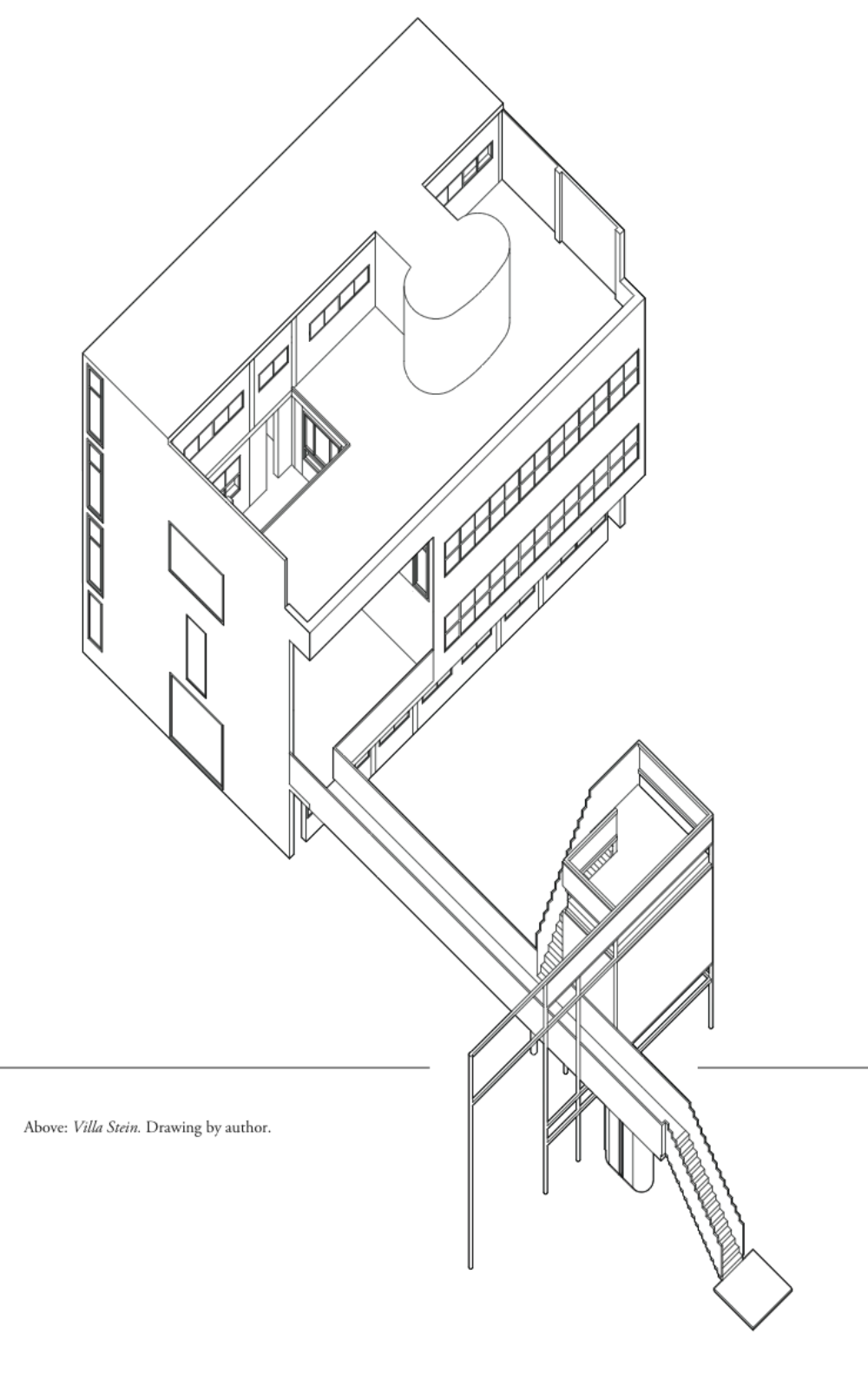
Presented as a tightly packed extruded rectangle, Villa Stein is summarized in Le Corbusier’s Four Compositions as “very difficult, but satisfying to the spirit because of it pure form.”22 Max Risselada, Beatriz Colomina, Raumplan versus Plan Libre: Adolf Loos and Le Corbusier, 1919-1930, (New York: Rizzoli, 1993), 132. Free plans on three consecutive floors are organized on the Palladian tartan grid of A/B1/A/B2/A. In Villa Stein, the left-hand service stair is rotated 90 degrees and displaced out of its bay (B2).23 Kenneth Frampton, Modern Architecture 1920-1945, (New York: Rizzoli, 1987), 295. In elevation, the house is understood through the layering of three principal facades and the establishment of sequential thresholds. To enter the house, one must first ascend stairs to a bridge that passes through the first facade of the project, one that signifies entry and identifies the outermost boundary of the “absent” form. The second facade addresses the visitors. The play of disposed symmetry, regulating lines, and volumetric accents guide the visitor toward the main entry, which is protected by a large, covered porch. While the second facade operates freely from its programmatic associations, the third facade, the rear facade, is differentiated by balconies that vary in size according to their adjacent interior spaces.24 Max Risselada, Beatriz Colomina, Raumplan versus Plan Libre: Adolf Loos and Le Corbusier, 1919-1930, (New York: Rizzoli, 1993), 132. Operating independently yet in sequence, the three facades establish a proper architectural promenade, carefully connecting man to machine.